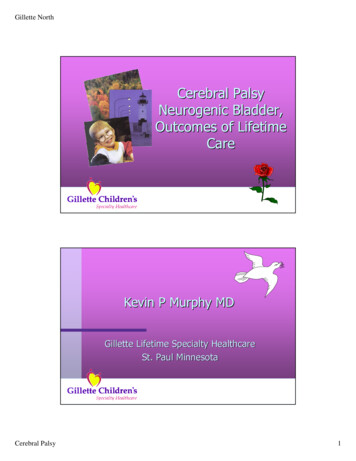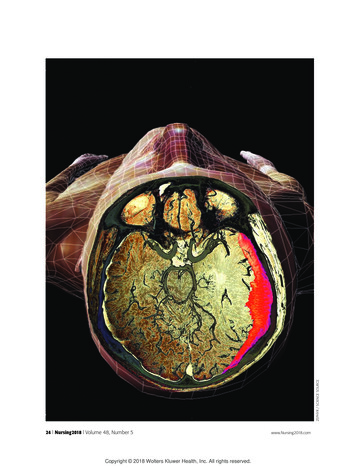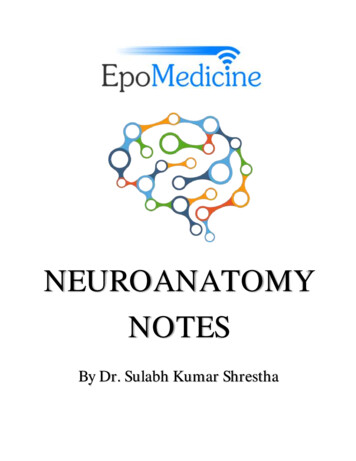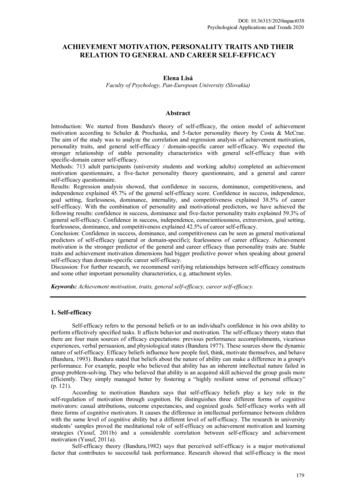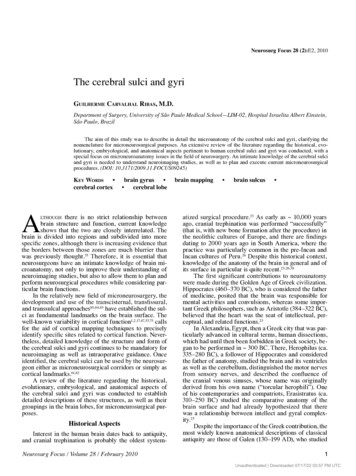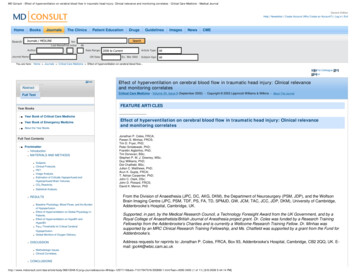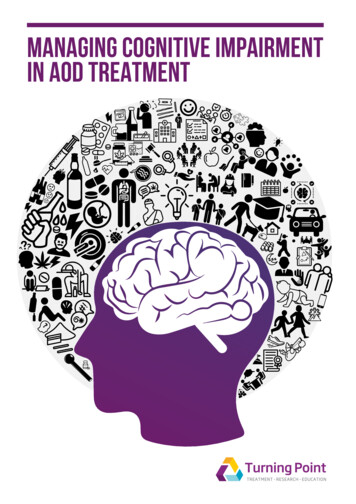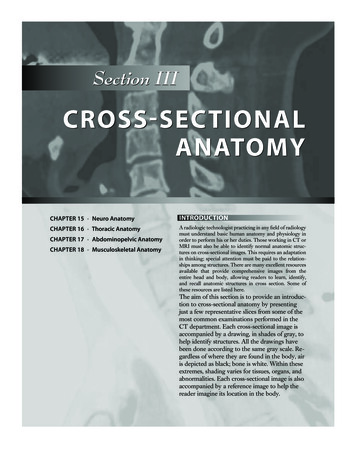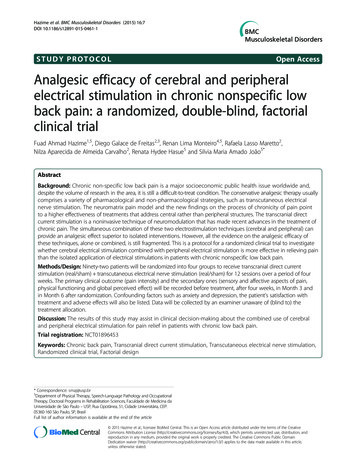
Transcription
Hazime et al. BMC Musculoskeletal Disorders (2015) 16:7DOI 10.1186/s12891-015-0461-1STUDY PROTOCOLOpen AccessAnalgesic efficacy of cerebral and peripheralelectrical stimulation in chronic nonspecific lowback pain: a randomized, double-blind, factorialclinical trialFuad Ahmad Hazime1,5, Diego Galace de Freitas2,3, Renan Lima Monteiro4,5, Rafaela Lasso Maretto2,Nilza Aparecida de Almeida Carvalho2, Renata Hydee Hasue5 and Silvia Maria Amado João5*AbstractBackground: Chronic non-specific low back pain is a major socioeconomic public health issue worldwide and,despite the volume of research in the area, it is still a difficult-to-treat condition. The conservative analgesic therapy usuallycomprises a variety of pharmacological and non-pharmacological strategies, such as transcutaneous electricalnerve stimulation. The neuromatrix pain model and the new findings on the process of chronicity of pain pointto a higher effectiveness of treatments that address central rather than peripheral structures. The transcranial directcurrent stimulation is a noninvasive technique of neuromodulation that has made recent advances in the treatment ofchronic pain. The simultaneous combination of these two electrostimulation techniques (cerebral and peripheral) canprovide an analgesic effect superior to isolated interventions. However, all the evidence on the analgesic efficacy ofthese techniques, alone or combined, is still fragmented. This is a protocol for a randomized clinical trial to investigatewhether cerebral electrical stimulation combined with peripheral electrical stimulation is more effective in relieving painthan the isolated application of electrical stimulations in patients with chronic nonspecific low back pain.Methods/Design: Ninety-two patients will be randomized into four groups to receive transcranial direct currentstimulation (real/sham) transcutaneous electrical nerve stimulation (real/sham) for 12 sessions over a period of fourweeks. The primary clinical outcome (pain intensity) and the secondary ones (sensory and affective aspects of pain,physical functioning and global perceived effect) will be recorded before treatment, after four weeks, in Month 3 andin Month 6 after randomization. Confounding factors such as anxiety and depression, the patient’s satisfaction withtreatment and adverse effects will also be listed. Data will be collected by an examiner unaware of (blind to) thetreatment allocation.Discussion: The results of this study may assist in clinical decision-making about the combined use of cerebraland peripheral electrical stimulation for pain relief in patients with chronic low back pain.Trial registration: NCT01896453Keywords: Chronic back pain, Transcranial direct current stimulation, Transcutaneous electrical nerve stimulation,Randomized clinical trial, Factorial design* Correspondence: smaj@usp.br5Department of Physical Therapy, Speech-Language Pathology and OccupationalTherapy, Doctoral Programs in Rehabilitation Sciences, Faculdade de Medicina daUniversidade de São Paulo – USP, Rua Cipotânea, 51, Cidade Universitária, CEP:05360-160 São Paulo, SP, BrasilFull list of author information is available at the end of the article 2015 Hazime et al.; licensee BioMed Central. This is an Open Access article distributed under the terms of the CreativeCommons Attribution License (http://creativecommons.org/licenses/by/4.0), which permits unrestricted use, distribution, andreproduction in any medium, provided the original work is properly credited. The Creative Commons Public DomainDedication waiver ) applies to the data made available in this article,unless otherwise stated.
Hazime et al. BMC Musculoskeletal Disorders (2015) 16:7BackgroundLow back pain is one of the main musculoskeletal complaints in clinics and hospitals and is still one of the sixmost often found health conditions in developed countries[1]. In Brazil, this condition is the second most prevalentchronic health condition, second only to systemic venoushypertension [2]. Recent estimates suggest a prevalence of11.9%, and the overall number of individuals with lowback pain considerably increases with the aging population [3]. The breadth of this condition’s socioeconomicimpact and its effect on quality of life make it one of thegreatest public health challenges worldwide [4-6].Many efforts have been made to find effective treatments; however, back pain remains difficult to treat [7].Conservative analgesic therapy usually comprises a varietyof strategies, such as medication, acupuncture, kinesiotherapy, manual and behavioral therapy, multidisciplinary approaches and the use of physical methods such astranscutaneous electrical nerve stimulation (TENS) [8,9].Despite being used for more than 20 years, TENS still presents controversial results, thus hampering its use as aneffective treatment for chronic non-specific [10-13] lowback pain. Many studies showing some evidence of TENSfor pain relief show methodological flaws; in addition, thelong-term benefits of this technique are not clear, as theeffects occur especially during application [14,15].New concepts like neuromatrix of Melzack [16] proposeparticipation of brain mechanisms in pain chronicity, thusholding in check treatments that exclusively address peripheral structures. Moreover, studies focusing on neuroimaging showed structural and functional changes in thecerebral cortex of people with chronic musculoskeletalpain [17-19]. In the brain, sensorimotor control mechanisms therefore seem to contribute to the emergence andmaintenance of the painful condition. Although somestudies have shown that peripheral stimulation such ashigh frequency TENS can inhibit cortical excitability[20-22] this technique could be insufficient in modulatingperipheral and central pain amplification, especially at encephalic levels, where “ill plastic adaptations” occur as aresult of chronic low back pain [23-25].Accordingly, treatments specifically addressing the cerebral cortex can complement the action of peripheral interventions and result in a more effective tool for the relief ofchronic pain. The transcranial direct current stimulation(tDCS), despite not being a new modality, has presentedrecent advances in the treatment of chronic pain [26-30],establishing itself as a promising therapeutic tool. LikeTENS, tDCS is a well-tolerated noninvasive low-cost technique with minimal side effects [31,32].According to our literature review, there are only threestudies involving the tDCS technique in chronic nonspecific low back pain: (1) a protocol study without prior results [33], (2) an exploratory study with only onePage 2 of 8application of tDCS [34] and (3) an exploratory randomized double-blind study [35]. Taken together, these studiesshowed no significant differences in pain relief betweenreal and sham tDCS. Although the results may indicatethat transcranial stimulation may not be enough to changethe perception of pain, conclusions about the effectivenessof this technique in chronic low back pain should be cautious in view of the characteristics of the experiments.Transcranial stimulation associated with peripheral stimulation was investigated in only two studies. In patientswith neurogenic pain in the arm, the combination of thesetechniques achieved greater reduction in pain than theisolated application of transcranial stimulation [36]. Ina recent study, Siobhan and colleagues (2014) demonstrated that the combination of peripheral and transcranial stimulation was more effective in relieving thesymptoms of chronic low back pain and mechanisms ofcortical organization and sensitization than the interventions applied alone [37]. The promising results ofthese two cross-sectional clinical studies indicate thepossibility of a synergistic action of the cortical andperipheral stimulation, and hence a more potent analgesic effect. However, there is a critical need for randomized clinical trials to generalize these findings andproduce the best data available for clinical decisionmaking.The identification of effective non-invasive and nonpharmacological treatments can trigger a substantial gainin pain relief and physical capacity, resulting in decreasedmorbidity and lower costs associated with low back pain.By simultaneously combining the two electrical stimulation techniques (cerebral and peripheral), the analgesic effect could be enhanced by the reorganization of corticalneuron activity and by the segmental inhibition of nociceptive stimulus. The aim of this experiment is to investigate whether cerebral and peripheral electrical stimulationcombined are more effective in relieving pain than the isolated application of electrical stimulations in patients withchronic nonspecific low back pain.ObjectiveThe primary objective of this study is to investigate theanalgesic efficacy of transcranial (cerebral) direct currentstimulation combined with transcutaneous (peripheral)electrical nerve stimulation in patients with chronicnonspecific low back pain compared with cerebral andperipheral electrical stimulations applied alone. The analgesic efficacy will be analyzed through the decrease ofpain intensity four weeks after randomization.The secondary objectives are:To analyze the difference between cerebral, peripheraland combined stimulations in pain intensity in patientswith chronic nonspecific low back pain assessed inMonth 3 and in Month 6 after randomization.
Hazime et al. BMC Musculoskeletal Disorders (2015) 16:7To analyze the difference between cerebral, peripheraland combined stimulations in the sensory and affectiveaspects of pain in patients with chronic nonspecific lowback pain assessed after four weeks, in Month 3 and inMonth 6 after randomization.To analyze the difference between cerebral, peripheraland combined stimulations in the functional capacity ofpatients with chronic nonspecific low back pain assessedafter four weeks, in Month 3 and in Month 6 afterrandomization.To analyze the difference between cerebral, peripheraland combined stimulations in the perception of theoverall effect of patients with chronic nonspecific lowback pain assessed after four weeks, in Month 3 and inMonth 6 after randomization.To analyze the patients’ satisfaction with the treatment.HypothesisOur hypothesis is that tDCS and TENS simultaneouslycombined are more effective in reducing the intensityand sensory aspect of pain, presenting less disability andhaving a better effect on global perception when compared to patients receiving the treatments alone.Page 3 of 8Methods/DesignA controlled factorial (2 2) clinical trial will be conducted to evaluate the analgesic efficacy of cerebral andperipheral stimulation in chronic low back pain (Figure 1).Approval and registrationThis project was approved by the Ethics Committee ofthe School of Medicine, University of São Paulo (USP)(protocol 308/13). The study will be conducted at theClinical School of Physiotherapy, School of Medicine,USP, and at the Rehabilitation Center of the Irmandadeda Santa Casa de Misericórdia de São Paulo, São Paulo,Brazil.ProceduresPatients with complaints of low back pain who seektreatment at the physiotherapy clinic of the School ofMedicine, USP, and at the physiotherapy clinic of theIrmandade da Santa Casa de Misericórdia de São Paulo,will be initially evaluated by the medical staff of the institutions. After the diagnosis of chronic nonspecificlow back pain and referral to the physiotherapy services, the patients will be thoroughly informed aboutthe present study. The physiotherapist responsible forFigure 1 Flow chart illustrating the process of the study. tDCS and TENS indicate transcranial direct current stimulation and transcutaneouselectrical nerve stimulation, respectively.
Hazime et al. BMC Musculoskeletal Disorders (2015) 16:7the evaluations will clarify the objectives of the study,possible treatments, eligibility criteria and potentialrisks resulting from the application of cerebral and peripheral stimulations. Patients who agree to the conditions and sign the consent form may participate.Participants who meet the eligibility criteria will be included in the study.Participants and eligibilityThis study will involve 92 participants (both genders)who seek treatment at one of our rehabilitation centersthrough medical referral complaining of nonspecific lowback pain for more than three months.Participants who meet the following criteria will be eligible: (1) age between 18 and 65 years, (2) medical diagnosis of nonspecific low back pain present for at leastthree months, (3) spontaneous search for treatment and(4) signature of informed consent.Participants will be excluded from the survey underthe following conditions: (1) low back pain assessed 4by Numeric Rating Scale (NRS) during one-week dailymonitoring (patient registration); (2) previous spine surgery less than six months ago; (3) previous treatmentwith TENS less than six months ago; (4) previous tDCStreatment; (5) disk herniation with nerve compressionwith neurological compromise; (6) neurological, psychiatric and rheumatologic diseases; (7) use of pacemakersor other implanted devices; (8) pregnancy; (9) drug useand (10) abuse of medicines and alcoholic beverages.The regular use of prescribed medications will not bean exclusion criterion, but the dose and type of medication will be recorded and documented. Patients withmoderate psychiatric comorbidities such as anxiety anddepression that are under medical supervision will notbe excluded.Randomization and allocation concealmentBefore starting treatment, a randomized generating program will place patients in one of the four groups: (1) realtranscranial direct current stimulation (tDCS-r) realtranscutaneous electrical nerve stimulation (TENS-r), (2)real transcranial direct current stimulation (tDCS-r) sham transcutaneous electrical nerve stimulation (TENSs), (3) sham transcranial direct current stimulation (tDCSs) real transcutaneous electrical nerve stimulation(TENS-r) and (4) sham transcranial direct current stimulation (tDCS-s) sham transcutaneous electrical nervestimulation (TENS-s). The randomization and allocationconcealment will be carried out by a collaborator not participating in the research, who should organize the patients’ records and their previously allocated treatments inindividual opaque envelopes. The schedule of treatmentwill be revealed to the physiotherapist responsible for thetreatments at the moment of electrical stimulationPage 4 of 8application. The “blinding” of evaluator and patients willbe kept until the end of the research and data processing.Initial evaluationAfter the fulfillment of eligibility and subsequent adherence and signature of the consent term, information onparticipants will be collected through a structuredinterview. Data will include personal data, clinicalhistory and radiological findings (if any) and anthropometric characteristics. Subsequently, a clinical psychofunctional evaluation will be conducted according tothe recommendations of the Initiative on Methods,Measurement, and Pain Assessment in Clinical Trials(IMMPACT) for clinical trials of effectiveness of treatment for chronic pain [38]. The main outcomes to beincluded in the clinical trials include six aspects: (1)pain, (2) physical functioning, (3) emotional functioning, (4) classification of improvement and patient’s satisfaction, (5) symptoms and adverse events and (6)patient’s approval.Primary variablePain intensityPain intensity will be assessed on a numerical scale of 11points (0–10), 0 accounting for no pain and 10 for theworst pain possible. The patient will be asked to describethe pain of the past seven days [39]. Pain intensity willalso be assessed before and immediately after the application of protocols over the 12 sessions.Secondary variablesSensory and affective aspects of painThe short version of the McGill Questionnaire (SFMPQ) contains 15 descriptors of pain sensation (11sensory and four affective), each descriptor rated on a4-point scale where 0 none, 15 mild, 25 moderate,and 35 severe [40]. Three measurements of pain experience based on sensory and affective descriptors canbe obtained: (1) PRI-T is the sum of all 15 descriptorswith the total score ranging from 0 to 45, (2) PRI-S(sensory) is the sum of descriptors 1 through 11 withthe total score ranging from 0 to 33 and (3) PRI-A(affective) consists of the sum of descriptors 12 to 15with the total score ranging from 0 to 12. The SF-MPQalso includes the visual analog scale (VAS) and thepresent pain intensity (PPI) of the long version of McGill questionnaire.Physical functioningThe Roland Morris disability questionnaire assesses theoverall functional capacity of the patient through the physical limitations resulting from low back pain. The questionnaire consists of 24 questions related to the normalactivities of daily life, each affirmative answer corresponding
Hazime et al. BMC Musculoskeletal Disorders (2015) 16:7to one point. The final score is determined by the sum ofthe scores. Values close to zero mean the best results, i.e.lower limitation, and values close to 24, the worst results,i.e. greater limitation. The highest number of responses isrelated to greater disability due to low back pain [39,41,42].Perception of global effectThe effect felt as a result of treatment will be assessedby the scale of global perceived effect that assesses theperceived level of the patient’s recovery from the treatment, comparing the initial symptoms with those of thelast days. The resource is a numerical 11-point scale ranging from 5 to 5, with 5 extremely ill, zero nochange, and 5 completely recovered, with the highestscore representing the fullest recovery [39].Other outcomesEmotional functioning - confusion factorsDepression and anxiety may be important confoundingfactors that influence the improvement of the patient’spain. Thus, symptoms of depression and general anxietywill be assessed at the beginning and the end of treatment by the Brazilian version of the Beck Depression Inventory (BDI) [43] and Visual Analog Scale (VAS),respectively. The BDI is a tool of self-assessment of depression using a questionnaire with 21 items whose intensity varies from 0 to 3 (higher scores indicating moredepressive symptoms). The VAS for general anxiety isassessed by a horizontal 100-mm-long line. The extremeleft end points to no anxiety, and the extreme right endto the worst anxiety possible [44].Symptoms and adverse eventsThe record of symptoms and adverse events resultingfrom the use of tDCS and TENS is passively collected bythe patient’s spontaneous reports. Active collection usesa questionnaire with records of the duration and intensity of adverse symptoms reported by the patient. Thenthe patients will be asked to rank the certainty of theirclaims according to a Likert scale (1 no certainty and5 total certainty) [31].Patients’ approvalThe approval of patients receiving treatment will beevaluated by the Medrisk questionnaire, which measuresthe satisfaction of patients undergoing physical therapycare. This questionnaire consists of 20 items, 10 of themrelated to the therapist-patient interaction, eight not related to it and two items considered overall items. Thepatient chooses his or her level of satisfaction with eachitem by selecting a Likert-like scale ranging from 1(“strongly disagree”) to 5 (“strongly agree”) or by choosing option “not applicable,” where high scores representhigh satisfaction [45].Page 5 of 8Evaluation of the blind conditionThe evaluation of the blind condition of patients and theevaluator-therapist will be conducted at the end of fourweeks of treatment. Both will be asked to guess whichintervention was used for tDCS and TENS, whether realor sham. Then patient and evaluator will be required torank the certainty of their claims according to a Likertlike scale (1 no certainty, 5 total certainty). To ensurethat the evaluator is not induced to correctly guess theparticipants’ allocation, the latter will be instructed notto reveal which sensation was felt during the sessions.TreatmentsThe treatment will be carried out for four weeks, withthree sessions per week, totaling 12 sessions of electricalstimulation. The sessions will take place individually inschedules of alternate days from Monday to Saturday.The program of schedules will allow a 20-minute interval between sessions so as to avoid possible contact between patients.Measurements of the participants’ expectationsAfter the enrollment and initial assessment (pre-treatment) and before randomization, the participants will beinformed about the possible sensations arising from cerebral and peripheral stimulations. They will be informedthat the unit of electrical stimulation may cause a slighttingling, itching or burning sensation the entire time oronly at the beginning of application. The difference in sensations occurs according to the sensitivity of each individual. Participants will also be informed about the possibilityof no perceptible sensation during the procedure. Regardless of the stimulus felt, all participants will be instructednot to reveal the sensation experienced.Transcranial Direct Current Stimulation (tDCS)The transcranial stimulation is applied by a DC generatorpowered by a 9-volt battery (Activadose II, USA). Thecurrent will be applied using two electrodes (35 cm2; 5 7 cm) (Ibramed, Brazil) covered by a sponge damped withphysiologic saline (salt solution 1%) and fixed to the headwith elastic bands.The assembly of the electrodes will be made according to the International 10–20 System of EEG [46] tobetter focus the primary motor cortex. The positivelycharged electrode (anode) will be placed at C3 or C4(counterlateral to the side of pain complaint), and thenegatively charged electrode (cathode) in the supraorbital ipsilateral region [29]. For patients experiencingpain in the central region of the lumbar spine, theanode will be placed on the side counterlateral to thedominant upper limb of the patient, as described inprevious studies [47,48].
Hazime et al. BMC Musculoskeletal Disorders (2015) 16:7The groups that receive the real tDCS (tDCS-r) will betreated with electrical current intensity of 2 mA, densityof 0.057 mA/cm2 and application time of 20 minutes[29]. The groups with sham tDCS (tDCS-s) will receivecerebral stimulation within the same parameters, but theapplication time will be only 30 seconds [35]. This feature of sham stimulation is usually used [47,48] becausethe tingling sensation on the skin below the electrodeusually disappears after 30s. Thus, the placebo effect ismore effectively monitored.Page 6 of 8calculation, there must be a total of 75 participants.However, considering 20% of sample loss, a sample sizeof 92 participants (23 per group) was calculated.Statistical analysisAll statistical procedures will be performed according tothe principles of intention to treat. Linear mixed modelswill be used to identify intra- and inter-group differencesat the end of treatment and in Month 3 and Month 6 offollow-up. All data will be analyzed using software SPSSv.20 for Windows. The level of significance is 0.05.Transcutaneous Electrical Nerve Stimulation (TENS)The peripheral stimulation will be applied through arectangular asymmetric two-phase electrical current apparatus (Neurodyn III Ibramed, Brazil). Both units ofstimulation (real or sham) will be applied, using fourself-adhesive electrodes (VALUTRODE 5 9 cm). Theelectrodes will be placed in a paralleled and bilateralposition of the lumbar segment on the painful area.The groups that will receive the real TENS (TENS-r)will be treated with current intensity (amplitude) according to their sensory threshold, characterized as an intense, yet comfortable, pulse frequency of 100 Hz, pulseduration of 200 μs and application time of 40 minutes[15]. During application, the patients will be asked abouttheir perception of TENS intensity every five minutesand, when they get used to the sensation, the intensitywill be increased again until the return of the sensorythreshold.Although some studies report no differences betweenhigh (100 Hz) and low (4 Hz) frequency for the treatmentof chronic low back pain [13], prolonged use of opioid analgesics (activation of μ receptors) can induce tolerance tothe drug and interfere with the effect of TENS, especiallywhen low frequency is used [49]. Groups with sham nervestimulation (TENS-s) will receive the same stimulationparameters, but the application time, like sham tDCS, willbe only 30 seconds. The sham and the real TENS equipment will have the same appearance, but, after the initial30 seconds, the current amplitude will gradually decreaseto 15 seconds until it reaches zero, thereby stopping theissuance of the electric current. The equipment will remain inactive for the rest of the application, maintaining alight on during the whole process. The same occurs withthe real stimulation machine.Sample sizeThe sample size was a priori estimated by the analysis ofpower [50] to detect a clinically important minimal difference (10% reduction from the baseline) in the outcome of pain intensity measured by the NumericalRating Scale for Pain [51]. The effect size and the probability of error type 1 (α) and type 2 (β) were 0.33, 0.05and 0.20, respectively. According to the data of sampleDiscussionAccording to our review, this is the first randomizeddouble-blind clinical trial to investigate the analgesic efficacy of transcranial direct current stimulation (tDCS)combined with transcutaneous electrical nerve stimulation (TENS) in patients with chronic nonspecific lowback pain. The factorial design used in this study willallow three interventions to be evaluated simultaneously:cerebral stimulation, peripheral stimulation and combined stimulation. Furthermore, the use of sham tDCSand sham TENS represents a more robust experimentaldesign to control the placebo effects. The results of thisstudy will provide important information for clinicalpractice and conservative management of chronic lowback pain. The possibility of synergistic and additive effect of these noninvasive, nonpharmacological, welltolerated techniques presenting minimal adverse effectscan turn them into a promising therapeutic tool forhealth professionals, improving the health status of thepopulation and reducing the socioeconomic consequences of chronic low back pain.Competing interestsThe authors declare no conflict of interest related to this manuscript.Authors’ contributionsFAH, DGF, RLM, RLM, NAAC, RHH, SMAJ were responsible for the studydesign. All authors read and approved the final manuscript.Author details1Department of Physical Therapy, Universidade Federal do Piauí – UFPI,Avenida São Sebastião, 2819, CEP: 64202-020 Parnaíba, PI, Brasil. 2Departmentof Physical Therapy, Irmandade Santa Casa de Misericórdia de São Paulo, RuaDr Cesário Motta Jr, 112, CEP: 01221-020 São Paulo, SP, Brasil. 3Department ofPhysical Therapy, Universidade Paulista – UNIP, Rua Antonio de Macedo, 505,CEP: 03087-040 São Paulo, SP, Brasil. 4Department of Physical Therapy,Universidade Federal do Amapá – UFAP, Macapá, AP – Brasil, Rod. JuscelinoKubitschek Km 02, CEP: 68903-419 Macapá, AP, Brasil. 5Department of PhysicalTherapy, Speech-Language Pathology and Occupational Therapy, DoctoralPrograms in Rehabilitation Sciences, Faculdade de Medicina da Universidade deSão Paulo – USP, Rua Cipotânea, 51, Cidade Universitária, CEP: 05360-160 SãoPaulo, SP, Brasil.Received: 16 July 2014 Accepted: 13 January 2015References1. Lamb SE, Hansen Z, Lall R, Castelnuovo E, Withers EJ, Nichols V, et al. Groupcognitive behavioural treatment for low-back pain in primary care: a
Hazime et al. BMC Musculoskeletal Disorders (2015) 20.21.22.23.24.25.randomised controlled trial and cost-effectiveness analysis. Lancet.2010;375:916–23.Brazilian Institute of Geography and Statistics (IBGE). Brazilian Institute ofGeography and Statistics (IBGE). National Sampling Study of Households. APanorama of Health in Brazil: access to and utilization of services, healthconditions and risk factors and protection of health 2008. In: Book BrazilianInstitute of Geography and Statistics (IBGE). Brazilian Institute of Geographyand Statistics (IBGE): National Sampling Study of Households. A Panoramaof Health in Brazil: access to and utilization of services, health conditionsand risk factors and protection of health 2008.Hoy D, Bain C, Williams G, March L, Brooks P, Blyth F, et al. A systematic reviewof the global prevalence of low back pain. Arthritis Rheum. 2012;64:2028–37.Airaksinen O, Brox JI, Cedraschi C, Hildebrandt J, Klaber-Moffett J, Kovacs F,et al. Chapter 4. European guidelines for the management of chronicnonspecific low back pain. Eur Spine J. 2006;15 Suppl 2:S192–300.Costa Lda C, Maher CG, McAuley JH, Hancock MJ, Herbert RD, RefshaugeKM, et al. Prognosis for patients with chronic low back pain: inceptioncohort study. BMJ. 2009;339:b3829.Dagenais S, Caro J, Haldeman S. A systematic review of low back pain cost ofillness studies in the United States and internationally. Spine J. 2008;8:8–20.Fourney DR, Andersson G, Arnold PM, Dettori J, Cahana A, Fehlings MG,et al. Chronic low back pain: a heterogeneous condition with challenges foran evidence-based approach. Spine. 2011;36:S1–9.Machado LA, Kamper SJ, Herbert RD, Maher CG, McAuley JH. Analgesiceffects of treatments for non-specific low back pain: a meta-analysis ofplacebo-controlled randomized trials. Rheumatology. 2009;48:520–7.van Middelkoop M, Rubinstein SM, Kuijpers T, Verhagen AP, Ostelo R, KoesBW, et al. A systematic review on the effectiveness of physical andrehabilitation interventions for chronic non-specific low back pain. Eur SpineJ. 2011;20:19–39.Carroll D, Moore RA, McQuay HJ, Fairman F, Tramer M, Leijon G.Transcutaneous electrical nerve stimulatio
5Department of Physical Therapy, Speech-Language Pathology and Occupational Therapy, Doctoral Programs in Rehabilitation Sciences, Faculdade de Medicina da Universidade de São Paulo - USP, Rua Cipotânea, 51, Cidade Universitária, CEP: 05360-160 São Paulo, SP, Brasil Full list of author information is available at the end of the article
